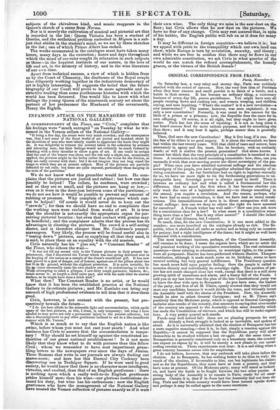ART IN THE PALACE.
PERHAPS the one thing that did George the Fourth most harm in general estimation, was the report that he made a regular busi- ness of consulting with his tailor on minute adaptations of his clothes to the niceties of his own shape, and that a standing amusement was the making of card-boxes. Castlereagh was re- deemed in the estimation of many when they heard that he was an enthusiastic and persevering admirer of the Beggar's Opera. These personal traits of men whose bent is of the liveliest interest to the public are apt to come out after death : we have the advan- tage of posterity in seeing some few things about our great people with distincter vision, but many things are altogether hidden from contemporary eyes. Accidents therefore are valuable which legi- timately supply the insight commonly withheld ; and the law proceedings that have divulged certain Royal recreations of our own day, however full of trouble for the parties concerned, cannot be altogether unwelcome to the public. That long list of etchings of which the Court of Chancery has forbidden the publication, while it tantalizes the/desire to see the work of the illustrious hands, discloses no small amount of inte- resting biographical information. Queen Victoria and Prince Albert have made the study of art a regular business : what card- boxes were to the young Queen's uncle, the practical work of drawing and engraving has been to her. We already knew that in music she was a proficient, as well as her husband. These are studies that adorn any life, from the lowliest to the very highest ; art, like love, is equal in its favours for humanity, and as much ex- alts the exalted as it does the humble. In the general run of the etchings, one recognizes the Prince's well-known turn for the mediteval, the Queen's liking for animals. A pretty union of art with the happy instincts of nature is displayed in the fact that the young mother's hand has been employed nearly a score of times within the range of the list in limning her eldest-born, the little Princess, besides other sketches of the Royal children. There are a few designs ; the Prince inclining to the picturesque subjects of the chivalrous kind, and music reappears in the Queen's sketch of a scene from Norma.
Nor is it merely the cultivation of musical and pictorial art that is recorded in the list : Queen Victoria has been a student of Goethe, and the sesthetical problem embodied in Mignon is a sub- ject that abides in the student's mind, as we see by three sketches in the list ; one of which Prince Albert has etched. The works enumerated in the catalogue must have taken many hours, many days in the execution ; hours and days throughout which the mind of our ruler sought its relaxation in such subjects as these—in the happiest instincts of our nature, in the love of life and art, in the memory of history, and in the wise literature of our own time.
Apart from technical success, a view of which is hidden from us by the Court of Chancery, the disclosure of the Royal couple thus diligently working together in the industrious democracy of art is highly interesting. It suggests the belief that the future biography of our Court will prove to be more agreeable and in- structive reading than some posthumous histories with which the world has been favoured. One would like to know with what feelings the young Queen of the nineteenth century set about the portrait of her predecessor the Bluebeard of the seventeenth, Henry the Eighth.



























 Previous page
Previous page